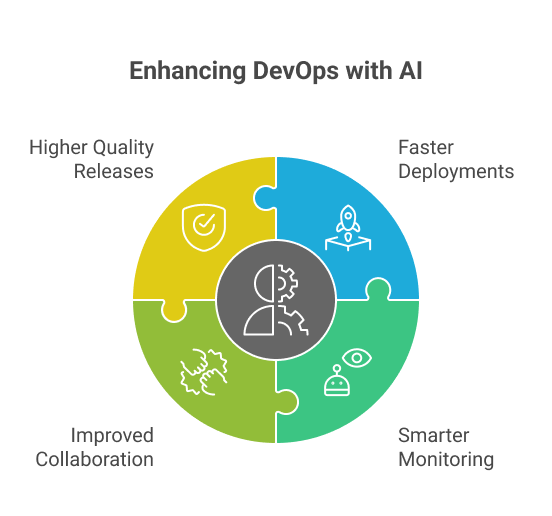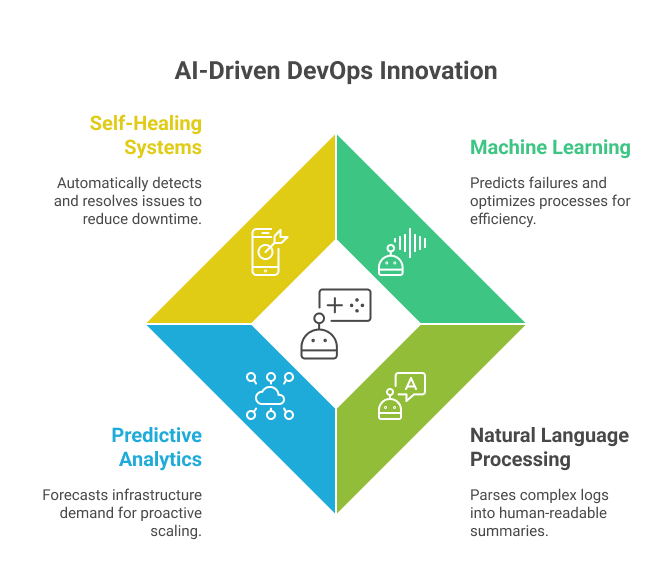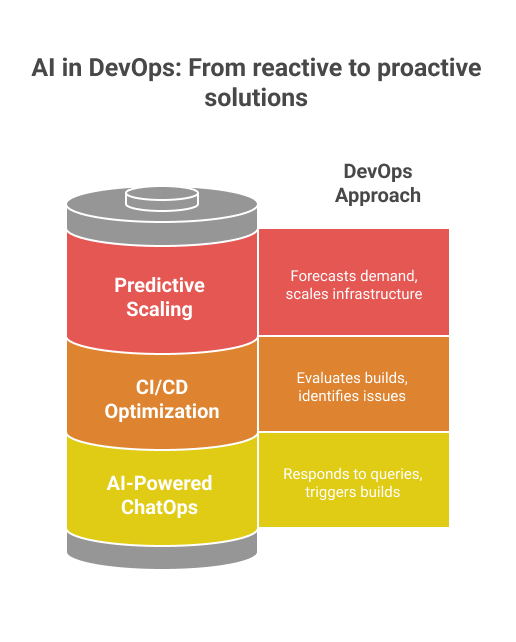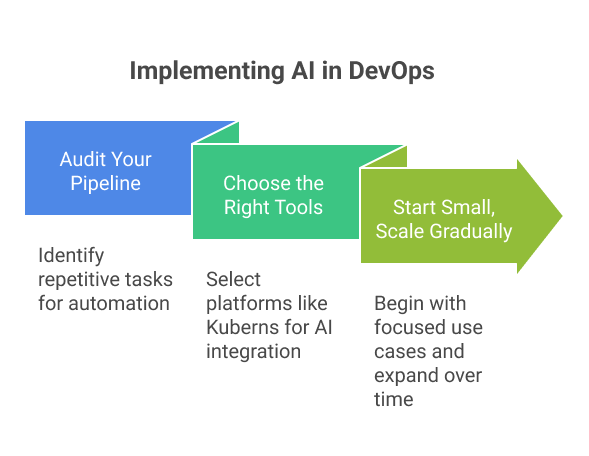Published
- 10 min read
AI for DevOps: The Secret to Faster, Smarter Software Delivery

Introduction
The demand for faster, more reliable software delivery has never been higher. Organizations are under constant pressure to release updates quickly while maintaining stability and performance. This challenge has led to the rise of AI for DevOps, an approach that integrates artificial intelligence into DevOps workflows to improve automation, predict issues before they occur, and optimize delivery processes.
By analyzing large volumes of operational data, AI can identify patterns, detect anomalies, and make intelligent recommendations that enhance every stage of the software lifecycle. For a deeper overview of the foundational concepts, our blog on What is AI-Powered DevOps? provides a comprehensive starting point. In this article, we focus on practical ways AI is transforming delivery pipelines and how solutions like Kuberns make adoption straightforward for development teams.
1. Why AI for DevOps is a Game-Changer
 Traditional DevOps pipelines often rely on manual oversight and reactive troubleshooting, which slows down delivery and increases operational overhead. AI for DevOps changes this approach by introducing predictive intelligence and automation that streamline the entire software lifecycle.
Traditional DevOps pipelines often rely on manual oversight and reactive troubleshooting, which slows down delivery and increases operational overhead. AI for DevOps changes this approach by introducing predictive intelligence and automation that streamline the entire software lifecycle.
By analyzing build histories, infrastructure metrics, and real-time application data, AI can anticipate issues before they cause disruption and recommend corrective actions. For example:
- Build failures can be detected earlier through predictive models trained on historical test results.
- Infrastructure scaling can occur automatically, using AI to forecast demand rather than relying solely on reactive triggers.
- Deployment risks are reduced with intelligent rollbacks that minimize downtime and protect user experience.
This proactive model leads to faster release cycles, more efficient resource management, and greater reliability in production environments. Platforms like Kuberns make it easier for teams to adopt these practices by combining Git-based deployments with AI-driven monitoring and automated scaling, removing much of the complexity typically associated with DevOps modernization.
2. Key Benefits of AI in DevOps
 The adoption of AI in DevOps introduces significant improvements across speed, reliability, and collaboration. By combining automation with predictive analytics, teams can optimize workflows and reduce risks throughout the software lifecycle.
The adoption of AI in DevOps introduces significant improvements across speed, reliability, and collaboration. By combining automation with predictive analytics, teams can optimize workflows and reduce risks throughout the software lifecycle.
Faster Deployments: AI can analyze historical build and deployment data to identify bottlenecks and recommend optimizations. With platforms like Kuberns, predictive deployment planning ensures updates are released at the right time, minimizing downtime and improving delivery speed.
Smarter Monitoring: Instead of depending on static alerts, AI continuously monitors logs, infrastructure metrics, and network activity to detect anomalies in real time. This proactive monitoring reduces the likelihood of incidents escalating into production outages. For practical strategies, explore our blog on How to Use AI in DevOps and Developer Workflow to Automate Deployments.
Improved Collaboration: AI-powered systems can highlight bottlenecks in pipelines and automatically assign tasks to the right team members. This creates smoother communication between developers and operations teams, helping them resolve issues faster and coordinate more effectively.
Higher Quality Releases: Through automated test generation, predictive defect detection, and quality scoring, AI strengthens release pipelines. This ensures that fewer bugs make it into production, leading to more reliable applications and improved user experiences.
3. Core AI Technologies Powering DevOps
 Several core AI technologies are driving innovation in modern DevOps practices, enabling teams to move from reactive processes to proactive, data-driven workflows.
Several core AI technologies are driving innovation in modern DevOps practices, enabling teams to move from reactive processes to proactive, data-driven workflows.
Machine Learning (ML): Used to predict failures before they occur, estimate delivery timelines based on historical data, and optimize build processes for speed and efficiency.
Natural Language Processing (NLP): Helps parse complex system logs and alerts into clear, human-readable summaries, allowing teams to identify and resolve issues more quickly.
Predictive Analytics: Enables accurate forecasting of infrastructure demand, ensuring resources are scaled appropriately ahead of time instead of relying on reactive responses.
Self-Healing Systems: Detects problems automatically and applies corrective measures without human intervention, reducing downtime and improving resilience.
Platforms like Kuberns bring these technologies together in a streamlined environment, making AI-driven DevOps accessible without complex YAML scripts or manual setup. To see how easy it is to get started, check out the Kuberns Getting Started Guide.
4. Real-World Applications of AI for DevOps
 AI is not just a future concept in DevOps, it is already reshaping how teams build, test, and deploy applications. Some of the most impactful applications include:
AI is not just a future concept in DevOps, it is already reshaping how teams build, test, and deploy applications. Some of the most impactful applications include:
Predictive Scaling: AI models can forecast demand spikes by analyzing traffic patterns, user activity, and historical performance data. This ensures infrastructure scales automatically before load increases, reducing downtime and improving user experience.
CI/CD Optimization: AI evaluates failed builds, identifies recurring issues, and recommends configuration or code changes to speed up delivery. This creates more stable pipelines and reduces the time engineers spend troubleshooting.
AI-Powered ChatOps Assistants: Intelligent assistants integrated into DevOps workflows can respond to deployment queries, trigger builds, or roll back releases in real time. This improves responsiveness and empowers teams to manage deployments more efficiently.
With Kuberns, these capabilities are not theoretical, they are embedded into the platform’s workflow, enabling teams to adopt AI in DevOps without reengineering their entire stack. For a deeper dive into how AI is transforming deployment practices, see our blog on How AI Tools Are Revolutionising Application Deployment.
5. How to Get Started with AI for DevOps
 Adopting AI in DevOps does not need to be overwhelming. By following a structured approach, teams can integrate AI step by step and realize benefits quickly.
Adopting AI in DevOps does not need to be overwhelming. By following a structured approach, teams can integrate AI step by step and realize benefits quickly.
Audit Your Pipeline : Start by identifying repetitive tasks or slow steps in your CI/CD process. These are usually the best candidates for automation and predictive analysis.
Choose the Right Tools : Platforms like Kuberns provide Git-based deployments, AI-driven monitoring, and automated scaling with minimal setup. For a deeper understanding of how AI fits into the DevOps ecosystem, see our blog on What is AI-Powered DevOps?.
Start Small, Scale Gradually : Begin with focused use cases such as AI-based monitoring or predictive scaling. Once those are established, expand gradually into automated deployments and self-healing systems for greater impact.
6. The Future of AI in DevOps
The future of DevOps is moving toward intelligent systems that can manage delivery pipelines with minimal human intervention. AI will not only automate tasks but also bring predictive intelligence into every stage of the development lifecycle. This means pipelines will be able to self-optimize, adapt to real-time conditions, and even forecast business impact before code is deployed.
A key development will be autonomous delivery pipelines, where AI continuously monitors code quality, infrastructure health, and user experience to ensure smooth, reliable releases. Instead of reacting to failures, the system will anticipate them, make corrective adjustments, and maintain stability automatically.
This is the vision that Kuberns is building toward. By combining Git-based deployments with AI-driven monitoring, predictive scaling, and self-healing systems, Kuberns is not just supporting DevOps practices but redefining them. It removes the complexity of manual setup, eliminates the need for extensive DevOps scripting, and enables teams to focus on innovation rather than infrastructure.
In many ways, Kuberns represents the next evolution of DevOps, where AI and automation are seamlessly integrated to create faster, smarter, and more resilient software delivery pipelines.
Conclusion
AI in DevOps is no longer a buzzword, it is a proven competitive advantage. By integrating AI into your software delivery process, you can achieve faster deployments, smarter monitoring, and more efficient workflows that reduce risk and improve reliability.
For a deeper understanding of the core principles, see our blog on What is AI-Powered DevOps?. If you are ready to take the next step, Kuberns provides a streamlined platform that brings AI-driven automation, predictive scaling, and self-healing systems directly into your DevOps pipeline.
Start your journey with Kuberns today and experience how AI can transform the way your team builds, deploys, and scales applications. Get started here.
Frequently Asked Questions (FAQs)
1. What is AI in DevOps? AI in DevOps refers to the integration of artificial intelligence techniques such as machine learning, predictive analytics, and automation into DevOps workflows. It helps teams automate repetitive tasks, predict failures, and optimize software delivery pipelines.
2. How does AI improve DevOps pipelines? AI improves DevOps pipelines by analyzing historical data, detecting anomalies in real time, and automating responses. This reduces downtime, speeds up deployments, and ensures higher quality releases.
3. Is AI for DevOps suitable for all teams? Yes, AI for DevOps can benefit teams of all sizes. Small teams can use AI for monitoring and predictive scaling, while larger enterprises can leverage it for advanced automation, quality assurance, and business impact forecasting.
4. Why choose Kuberns for AI-driven DevOps? Kuberns simplifies AI adoption by offering Git-based deployments, AI-powered monitoring, predictive scaling, and self-healing systems in one platform. This eliminates the need for complex DevOps scripts and helps teams innovate faster.
5. How can I start using AI in DevOps? You can begin by identifying repetitive tasks in your pipeline, adopting AI-based monitoring, and gradually expanding into predictive scaling and automation. To explore practical steps, see our guide on What is AI-Powered DevOps?.